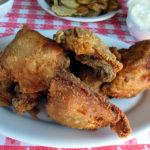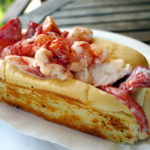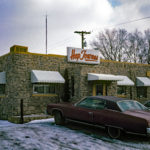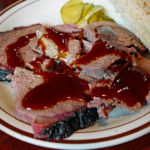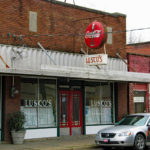Manny’s
Monday is the slowest day of the week at Manny's cafeteria, because Monday is the day people diet, trying to make amends for weekend excess. At Manny's, on Jefferson Street south of the Chicago Loop, you don't diet. You don't snack. You don't nosh. You come to this landmark lunchroom to pile your tray high and eat like there is no tomorrow. When you sink your teeth into a corned beef on rye, or plow a fork into a heap of oxtail stew, or sip the cool fizz of a chocolate phosphate through a straw, you are savoring Midwest city soul with all the fixin's. On Mondays, the line of devotees waiting to get in does not stretch down the sidewalk as it does most other days, but between noon and one every Formica table in both dining rooms is occupied, and hungry customers are getting rung past Ruby Medel's end-of-the-line tally station at such a good clip that many tables are shared by strangers.
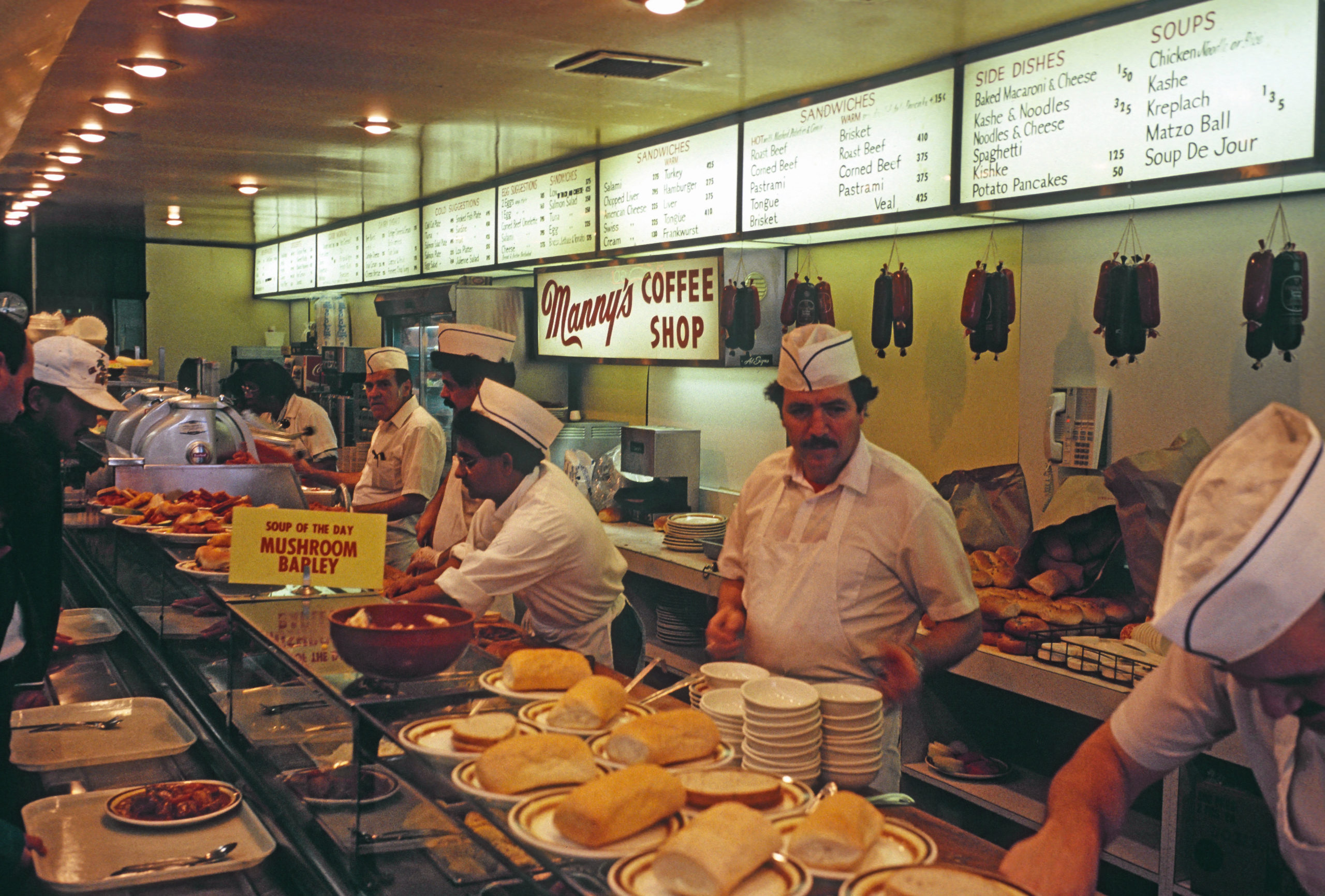
By Jane and Michael Stern
Originally Published 1994 Gourmet Magazine
Monday is the slowest day of the week at Manny’s cafeteria, because Monday is the day people diet, trying to make amends for weekend excess. At Manny’s, on Jefferson Street south of the Chicago Loop, you don’t diet. You don’t snack. You don’t nosh. You come to this landmark lunchroom to pile your tray high and eat like there is no tomorrow. When you sink your teeth into a corned beef on rye, or plow a fork into a heap of oxtail stew, or sip the cool fizz of a chocolate phosphate through a straw, you are savoring Midwest city soul with all the fixin’s. On Mondays, the line of devotees waiting to get in does not stretch down the sidewalk as it does most other days, but between noon and one every Formica table in both dining rooms is occupied, and hungry customers are getting rung past Ruby Medel’s end-of-the-line tally station at such a good clip that many tables are shared by strangers.
At Manny’s—though you might come without your friends, clients, business associates, accountant, attorney, parole officer, alderman, or image consultant—you are never really alone. Seating is perforce communal, and regulars feel free to hobnob loudly with each other even if they are four tables apart. Proprietor Ken Raskin (the late Manny’s son) works the rooms, greeting chowhounds who have known him since he was a small boy. Arlene (Ken’s mother, Manny’s widow, and now wife of Larry Mann, a longtime Manny’s customer) often spends the noon hour making the rounds to make sure all is right with the world. “Isn’t it nice to see how well they’re eating,” Arlene declares as she gazes over the restaurant with all the pride of a Jewish mother who has fashioned every matzo ball and kreplach with her own hands. “That’s what I like to see: clean plates and happy faces.”
So who are the happy ladies and gentlemen cleaning their plates at Manny’s?
Three executives from a meat packing company occupy one table, heralding what’s in their sandwiches as “the best, freshest, most consistent meat in the city—the real thing and nothing but.” Each man has slung his tie over his shoulder to ensure the neckwear doesn’t get splattered with julienne-salad dressing, juices from sliced brisket, knish crumbs, or shreds of pastrami. “It’s the Manny’s way,” one of the gentlemen explains.
Raymond Sloan, who operates a business nearby, has been a steady customer since the first Mayor Daley’s reign. He brags that he has eaten breakfast and lunch at Manny’s five days a week for the last twelve years and still has never had the exact same meal twice. Mr. Sloan, who is seventy-four, says, “Today I had tuna salad and lemonade. I like the gefilte fish, the spaghetti, and the brisket of beef. I love the corned beef, but unfortunately it doesn’t love me.” He especially enjoys entertaining clients at these bare tables under the bright fluorescent lights. “My Japanese associates are thrilled to come here. When I tell them where we’re going, they say `C.B. on rye!’ ”
Milly Kovan journeyed to Manny’s from Farmington Hills, Michigan. “This is such a flavor of Chicago,” she says. Mrs. Kovan is seated at an especially large table of six couples who all met a while ago in Scottsdale, Arizona, and decided to have a Chicago reunion.
Bernie Josephs (“the King of Foam Rubber,” Arlene tells us) is far and away the most dapper man in the restaurant. A Manny’s regular, he always sports an astonishing outfit in which one color is celebrated neck-to-toe. We meet him on powder-blue day: blue jacket and slacks with socks to match, striped pale-blue shirt and tie, and a silk pocket square blooming from his chest in a darker blue for contrast. On the opposite lapel is a Rotary Club pin awarded for years of service. Mention must be made, too, of Mr. Joseph’s topiary sculpted goatee: snowy white, in perfect pastel consonance with his suit. “I have been coming to Manny’s for over thirty years,” he proclaims. “The Salisbury steak is to be revered. Corned beef? My doctor said it isn’t good for me, but I must have my corned beef fix once every two weeks or I cannot function. I brought the doctor here one day. Now he’s a regular customer.”
Solly Hammer has been the most sought-after florist in this part of Chicago for decades. His clients include Gene and Georgetti, a venerable Chicago steak house. “I bring all my best customers to Manny’s—maitre d’s, the top hotel men. I’ve been coming for so long, I can’t remember how far back. I like looking around and seeing the same people. Ruby has been at the register thirty-some years. One of the busboys has been here twenty-seven, and now his sons are at Manny’s—isn’t that nice?” So, does Mr. Hammer come to Manny’s because he likes seeing the same people? “No, I come for the food! I live for it.”
If you eat at Manny’s enough times, it has been said, you will see everyone you know in Chicago. At midmorning the place is packed with taxi drivers having breakfast or lunch (depending on their shift) and schmoozing over coffee, Dr. Brown’s CelRay soda, or chocolate phosphates. During the first two weeks of April it is especially hard to get a seat because accountants and their clients occupy tables for hours, poring over records for income tax returns. Chances are good any day you will see a gent known as Seymour, who holds the honor of being Manny’s oldest customer, at ninety-six. His nurse brings him in, then goes through the cafeteria line for his chicken soup and a piece of gefilte fish. If Jackie Mason is in town, you will find him eating kasha varnishkes. Columnist Iry Kupcinet is a spaghetti man. And, before she moved to Washington to be a senator, Carol Moseley-Braun came in all the time for corned beef sandwiches.
There are always those in uniform: doc-tors and nurses dressed in white from the University of Illinois Hospital and Rush Presbyterian St. Luke’s, firefighters from the Chicago Fire Academy two blocks away, and police officers from headquarters at Eleventh and State across the Chicago River. Arlene recalls, “When we opened the second dining room, I suggested we install booths in addition to the tables, but Manny wouldn’t do it. He said that a policeman can’t sit in a booth because a bench seat makes it too hard to draw a gun.”
“Along with the famous, we get the infamous,” Ken Raskin says with a bit of a blush. “You know, those on the other side of the law. One time we had a table of them sitting at lunch when a group of detectives walked in. I didn’t notice anything until I heard the rear-door alarm sound. The gangsters had gotten up and run out the back, but they left money on the dishwashing machine in the kitchen to pay for their lunch. I guess they were honest crooks.”
If Damon Runyon had written about Chicago, Manny’s would have been his favorite setting. In a Chicago Tribune article that Barbara Mahany wrote about the place titled “Slice of Heaven,” she spotted “an alderman ‘with his chick of the week,’ an appellate judge, a state representative…shoe peddlers from Chernin’s across the street, a couple of soybean traders, the owner of a kosher salami factory in town and, over by the fire exit, a biggie in the rubber-hose business joined at his table by one of the biggest shoe-parts men in the city.”
Democratic consultant David “The Axe” Axelrod has been coming to Manny’s since he was a boy, and he made Manny’s the first stop on Rich Daley’s successful campaign for mayor in 1989. Daley, according to Ken Raskin, is a matzo ball man…despite the Tribune’s allegation that he asked for a corned beef sandwich on white bread, with mayonnaise. (“A filthy lie being spread by political opponents!” Axelrod told Barbara Mahany.) The late Mayor Harold Washington was a regular customer, too, favoring short ribs. “I know when they’re trying to hammer out a budget down in Springfield,” Ken Raskin says, “because we send down the big orders of corned beef sandwiches and potato pancakes for overtime work in the governor’s office.” Springfield, by the way, is about two hundred miles downstate.
It is corned beef you smell the moment you walk into Manny’s: that mouth-watering briny pickled-beef aroma as the meat glides off the slicing machine into hot brick-red heaps on the counter, then gets piled between slabs of seed-specked sour-crusted rye bread. Manny’s goes through 250 pounds of corned beef each day; Ken Raskin estimates they’ve sold 7 million sandwiches since the beginning, with 20 million latkes (potato pancakes) on the side.
Gino Gambarota, Manny’s corned beef man for the last ten years, cuts it the way you like—lean, fatty, or regular—but he will not cut it thick. “The art of cutting corned beef is to cut it as thin as possible, and against the grain,” Gino says. His slices are shaved so thin they verge on dis-integration; but they stay intact and are miraculously succulent. This is Chicago’s style with beef for sandwiches (the city’s famous Italian beef is like this too), and it is something of a shock for those accustomed to other delis’ thickly sliced corned beef and pastrami. “In New York, they do it differently,” Gino explains. “It’s cooked longer, so it can be sliced thick. In Chicago, you want your corned beef as thin as it can be. That’s the way for fullest flavor.”
Handfuls of this magnificent meat are stuffed into sandwiches large enough that many customers eat one half and save the other for later. The sandwiches get made and sold so quickly that during busy meal times Gino sets up four or five ready-made, each with a potato pancake on the plate, so customers in a hurry can bypass the hot food at the beginning of the cafeteria line and nab what they want without fuss at the sandwich counter. No prepared sandwich remains on the counter longer than forty-five seconds before someone speeds past and pulls it down onto a tray. “Step around for corned beef!” Ken or Arlene calls as their clientele crowd together at the start of the line. “Step around for sandwiches and latkes.”
The potato pancakes that go so well with the sandwiches are ovoid and hard-crusted but tender inside, made by plopping the batter into an iron skillet of bubbling oil and butter, then using a spoon to flatten the cake as it turns golden brown. Served hot, with sour cream or applesauce on the side, three or four of them would make a fine pure-potato meal.
Glorious as Manny’s signature corned beef sandwich is, there is more to relish on the vast menu. Other regular items include monumental meat-filled knishes—made with flour dough Mondays, Wednesdays, and Fridays and with mashed-potato dough Tuesdays, Thursdays, and Saturdays; chicken soup with matzo balls or little kreplach (meaty dumplings); creamed or pickled herring; and an array of such lunch counter classics as beef stew, liver and onions, meat loaf, and stuffed cabbage. A favorite during heat waves is “farmer’s chop suey,” a refreshing radish and cucumber salad.
Some Manny’s customers arrange their gastronomic life around the schedule of daily specials that almost never changes. Monday, you can count on corned beef hash, stuffed green peppers, and breaded veal chops. Wednesday is the day for chicken pot pie, turkey drumsticks, and mushroom barley soup. On Friday it’s fried smelts, macaroni and cheese, and perch. Thursday is the high point of the week for a large coterie of oxtail stew aficionados, but Ken makes only a limited amount (determined by the size of the pot he uses). “We bring it out at nine-thirty in the morning,” he says, “and by noon, it’s gone. They fight for it. They call ahead to reserve an order. They come in during coffee break and get some to take back to work for lunch.”
The recipes are old ones, some going back fifty years to when brothers Jack and Charlie Raskin, sons of Russian-Romanian immigrants, opened their first cafeteria, on Halsted Street. Their specialty was non-kosher Jewish cooking, served quickly in large portions—the way Charlie had learned by watching his mother. Today at Manny’s—a descendant of that original cafeteria—matzo balls are still enriched with real schmaltz (chicken fat), and the gefilte fish is always freshly made. Beef arrives at the cafeteria in steamship rounds (a seventy-five-pound cut), which Ken says he buys partly because customers like to see the big haunch of beef sliced at the sandwich counter but also because he uses all its by-products. “The bones are for beef stock; the fat we render and use to sauté onions; the trimmings are for hamburgers and meat loaf. I don’t like to buy ground beef—you don’t know what’s in it. We also need the leftovers from the roast beef to make kreplach and knishes.”
Ken explains that the oxtail stew is popular because few people go to the trouble of making it at home from scratch anymore; downstairs in the meat locker, he delights in waving a whole long oxtail at a squeamish visitor. He apologizes for today’s borscht (he feels it might be a little too sweet); but the pound cake, which he makes each morning after he arrives at three-thirty with the freshly baked bagels and hard rolls, is especially luxurious and to his liking.
Before Manny Raskin’s death, eleven years ago, no recipes were written down. Ken, who was twenty-seven at the time, realized that it was his responsibility to carry on his father’s reputation, so he went into the kitchen and trailed behind Eleanor Shelli, who had been the cook at Manny’s since 1965, with a tape recorder, noting everything she did for each dish. Now the recipes are written down, but not in any standard form. Measurement is in Eleanor’s handfuls, jars, and large and small scoops. The recipe for matzo balls, for example, is written this way:
MATZOH BALLS (Double Batch) — Split into 3 pots: 28 eggs, 27 teaspoons fat, 7 ½ -8 scoops matzoh meal, 2 cups water.
And the famous oxtail stew recipe reads something like this:
OXTAILS—Start them dry at 3:30. At 4:50 add fine onions, salt, pepper, garlic, and a jar of water. Let cook until 6:00 and add carrots, ¼ can Tomato Magic, ½ can purée, ¼ scoop sugar. At 6:50 add 1 ½ cans raw potatoes.
Done at 8:00.
Manny’s came into being shortly after World War II, when the Raskin brothers split up so that Jack could open his own restaurant on Roosevelt Road near the open-air market area called Maxwell Street. The restaurant Jack bought used to be named Sunny’s. So rather than tear down the old sign and get a whole new one, Jack named it after his teenage son, Emanuel (known as Manny), saving money by simply buying two letters and replacing the “Su” in “Sunny’s” with “Ma.” It was a shoestring operation at first, with Manny serving as the cook (he had learned by watching his uncle). The address changed a few times, and then in 1964 Manny’s moved to its current spot on Jefferson. Ken remembers his father saying, “I know what the people around here want, and I am the only one left who can do it.”
Even when Manny’s opened at this location thirty years ago, it was among the last of a unique style of urban eatery—the home-style, family-run cafeteria, bubbling with the spirit of its neighborhood and attracting patrons from all walks of life. In those early years, if you lived or worked anywhere in the vicinity you could hitch a ride on the Manny’s van that circled around making deliveries and picking up customers for lunch. Then, as now, it was situated in a polyglot part of the city with bargains that attract people from all over. Today, the gargantuan Chernin’s Shoes across the street advertises unbelievable markdowns as well as EXTRA WIDE, EXTRA LONG OUR SPECIALTY. Around the corner on Roosevelt Road, swank apparel is sold at Buy-a-Tux formal wear and at a fur outlet store with a sign saying, FUR NOW, FUR EVER.
At Manny’s the dining room walls are decorated with newspaper clippings, reviews, snapshots, and memorabilia demonstrating how deeply Chicagoans treasure this old restaurant—as a place to eat and meet, and as a memento of downtown the way it was a half century ago, a relic of the past. Near the cash register, where customers can buy cigars, candy, or a cassette tape of songs by one of the customers, Allan Lieberman (“the next Alan Sherman”), there is a collage of pictures someone took in 1986 when The Big Town, starring Matt Dillon, was filmed in Manny’s because the movie was set in the 1950s and Manny’s looked the part. Not far away is a handsome plaque awarded to Manny Raskin in 1975, inducting him into the Vienna Sausage Manufacturing Hall of Fame.
There are newspaper stories galore telling about the politicians and local VIPs who frequent Manny’s and what each of them likes to eat. There is a letter of con-gratulations from Illinois governor Jim Edgar on the occasion of the cafeteria’s fiftieth anniversary, declaring it “a Chicago landmark where people come together to take advantage of its relaxing atmosphere.” And there are pictures from the fiftieth anniversary celebration, held October 26, 1992, that show the yard-wide cake that everyone enjoyed. It was shaped like an overstuffed corned beef sandwich.
Unless you work, live, or shop in the neighborhood, Manny’s isn’t all that convenient to get to. Eager investors have approached Ken Raskin suggesting he open a “Manny’s North” in a place amenable to a more upscale clientele. “I couldn’t do that,” Ken explains, “because I couldn’t be two places at once. What they don’t understand is this: You cannot have a Manny’s without Manny. When my father passed away, some of the old-timers grumbled that it would never be the same again because he was gone. But they’ve stopped muttering, and now a lot of them have begun to call me Manny. That’s fine with me. It’s a good name.”
Discuss
What do you think of Manny’s?
Related Articles
Stroud’s
By Jane and Michael Stern Originally Published 1995 Gourmet Magazine Chicken...
The Lobster Roll Honor Roll
Maine is the only state in America that features a picture of cooked food on its license...
Meat-And-Three
A few years back, country singer Ray Stevens invited a New York friend to join him at one of...
Top 12 favorite Ice Cream Scoops
WITH THE EXCEPTION of the hot dog bun, there has never been an edible invention as...
Top 5 BBQ Restaurants | Western Kentucky
Get yourself to Western Kentucky for great BBQ I see the food shows on TV where...
Best restaurants in Greenwood, MS | Hot Licks Delta Style
Ever since we first ate margarine-sauced pompano at Lusco’s, in Greenwood,...

